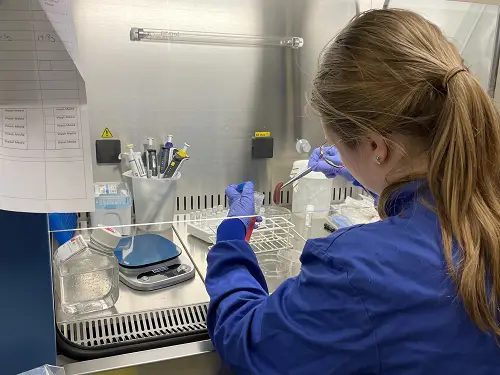‘Delving deeper’ into liver disease by re-creating it in a dish
Innovative research in Southampton is using a 3D technique to take new steps towards tackling a global health problem.
Millie-Rose Doolan is a PhD student at the University of Southampton. She is leading the project to re-create liver disease in a dish.
The aim is to better understand and identify new ways of treating Metabolic Dysfunction-Associated Steatotic Liver Disease (MASLD).
Millie’s PhD is funded by the NIHR Southampton Biomedical Research Centre (BRC). It is also funded by the NIHR Wessex Experimental Medicine Network, a joint initiative between the BRC and Wessex Health Partners.
A global health problem
MASLD is estimated to affect up to one in five people in the UK. Rates are increasing with rising levels of metabolic diseases such as obesity.
Previously known as non-alcoholic fatty liver disease (NAFLD), it is now understood to be strongly influenced by metabolic diseases and dysfunction. It is associated with obesity, as well as conditions such as type 2 diabetes and heart disease.
It is a chronic liver condition, with four stages. It starts with too much fat in the liver (steatosis).
This can cause inflammation, leading to the second stage, known as metabolic dysfunction-associated steatohepatitis (MASH).
The third stage is scarring (fibrosis). Excessive scarring will affect normal liver function, causing cirrhosis, and can lead to liver failure. Scarring also increases the risk of liver cancer.
“Fatty liver disease is a global health problem – the latest figures suggest that up to 30% of the global adult population will be affected,” explains Millie.
“The underlying biology of MASLD progression is unclear, and not all patients progress at the same rate or develop severe disease. Some patients develop liver cancer, where surgery or chemotherapy is required. Other patients remain in the early disease stages, which can be reversible via lifestyle changes.”

Creating 3D models from patient samples
MASLD research is limited by a lack of experimental systems that replicate what happens in different humans. Some laboratory tests can mimic some aspects of MASLD progression. However, there are significant differences compared to what happens in a patient.
Millie is developing 3D organoids to replicate MASLD, using liver samples donated by patients. These are three dimensional tissue cultures. She is using them to study the disease.
Her research will generate the organoids from surplus patient-donated liver tissue. Patients will only contribute one sample each.
By creating 3D organoids from across the entire disease progression, she will develop a human-based system. This will reduce the need for experimental animal models.
Millie aims to use this system to investigate the drivers of MASLD progression. She will identify factors that help the tissue repair itself, and see how the organoids respond to possible treatments.
“Currently, high-risk patients cannot be identified, and treatment options are limited.” she says. "By creating 3D organoids using patient tissue, we can delve deeper into how the disease progresses and identify potential targets for treatment.
“I’m proud to be carrying out this PhD, which will hopefully develop a better understanding of this disease to help patients in the future.”